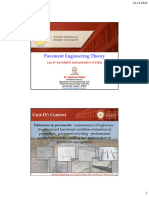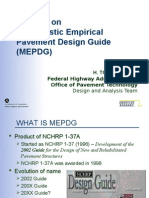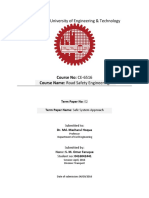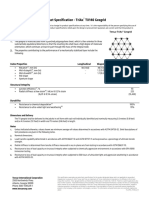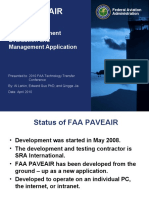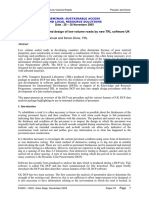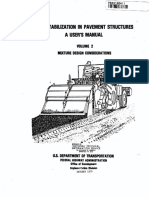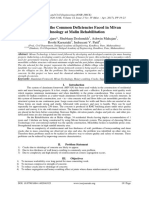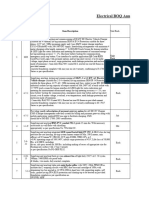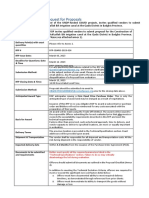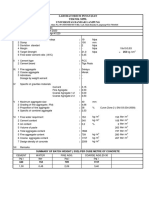About Elmod
About Elmod
Uploaded by
jose2086Copyright:
Available Formats
About Elmod
About Elmod
Uploaded by
jose2086Original Description:
Original Title
Copyright
Available Formats
Share this document
Did you find this document useful?
Is this content inappropriate?
Copyright:
Available Formats
About Elmod
About Elmod
Uploaded by
jose2086Copyright:
Available Formats
8th International Conference on Concrete Block Paving, November 6-8, 2006 San Francisco, California USA
ELMOD 6: THE DESIGN AND STRUCTURAL EVALUATION
PACKAGE FOR ROAD, AIRPORT AND INDUSTRIAL PAVEMENTS
Kars P. Drenth, Manager Consulting Engineering
Dynatest UK Ltd
3 Marquis Court, Marquis Drive
Moira, Derbyshire DE12 6EJ
United Kingdom
Tel: +44 1283 554860 Fax: +44 1283 552462
E-mail: kdrenth@dynatest.com
SUMMARY
ELMOD is an acronym for Evaluation of Layer Moduli and Overlay Design used or the
structural assessment of all kind of pavement structures. The latest version 6 of ELMOD is now
able to design pavement structures by specifying the pavement model, the mechanical
characteristics for all types of materials and an unlimited number of loading types.
Based on the stiffness values of each pavement layer a structural strength can be calculated using
mechanistic-empirical principles expressed as a remaining life, needed strengthening or required
pavement thickness. The software package is assigning various user controlled transfer functions
to each material and is able to apply seasonal adjustments for variations in subgrade modulus
due to for instance rainy seasons. The software package therefore may be used for any specific
local environmental condition.
Within the structural calculation it is possible to select any user-defined combination of design
loads using a vehicle library. Instead of a standard wheel load actual loads can be used in a
design which is in particular useful for pavements loaded by a mix of different vehicle types. For
many pavements the lateral distribution of vehicle loads is an important issue. This may be
entered based on a normal distribution function.
This paper describes the details of the design of a pavement structure with paver blocks as
surfacing layer based on a case study for a container terminal in Ghana.
1. INTRODUCTION
For the design of a pavement construction certain criteria have to be established to come to a sound
analysis. The characteristics and requirements of heavy-duty industrial pavements do differ
substantially compared to highway pavements. Port pavements are subjected to large numbers of
relatively high loads at low speed.
A design can be based on semi-empirical methods such as the British Ports Association/Interpave
method (BPA, 1996) based on multi-layer elastic modeling principles to produce design charts using
the Lusas finite element package for calibration of the Equivalent Single Wheel Load (ESWL)
concept. However such methods are limited in its use, especially in the application of alternative or
new materials and different types of transport equipment. Special care has to be taken with the fact
721
8th International Conference on Concrete Block Paving, November 6-8, 2006 San Francisco, California USA
that, especially with respect to cement bound pavement layers and concrete, a relative few repetitions
of heavy loads can be very damaging. The ESWL concept can be misleading under these conditions
due to the very steep fatigue relationships of cement bound materials in which a small increase of load
can result in a dramatic reduction in life time of a pavement structure (CROW, 2002).
ELMOD 6 software package has been used to undertake a design review of the paver blocks surfaced
pavement structures of the new extension of the Tema Port Stacking and Marshalling Area B in Ghana.
The new design module of this software package can be readily used for heavy duty industrial
pavements such as container terminals. It can handle the variety of mobile equipment used in container
facilities with wheel loads that can be of the order comparable to very large aircraft. One of the
features of the software is that it takes rational account of vehicle wander. This is the statistical
variation of the paths taken by successive vehicles. Increased wander reduces pavement damage and
could lead to significant savings. In the mechanistic-empirical approach all layers are represented by
their mechanical characteristics avoiding the use of material conversion factors.
In many cases concrete paver blocks are used as surfacing material mainly due to their superior
characteristics to withstand static loads. Container terminals show a wide variety of heavy dynamic
and static loads which makes paver blocks the most versatile product to be used under all these
different loading conditions. It is however not only the resistance to static loads that makes this
material so useful as surfacing under a wide variation of loading conditions, but also the ease it can be
maintained by just replacing damage blocks. There is a tendency to improve on its structural capacity
by moving from rectangular to shaped blocks to achieve more interlock, often referred to as
progressive stiffening, between the blocks. The heavier the loading the more its functionality does shift
towards a material protecting the surface of the main structural layers from being damaged. Creating
more interlock between the paver blocks could in that case by counter productive and possibly the
mean reason for an increase in paver breakage of especially shaped blocks.
2. DESIGN INPUTS
2.1 General
In the multi-layer elastic model the pavement structure is regarded as linear elastic, in which the
materials are characterised by Youngs Modulus of Elasticity (E) and Poissons Ratio (). The
materials are assumed to be homogeneous and isotropic, and the layers have horizontally infinite
dimensions. Similar to the finite element technique, the results of the output depend on the correctness
of the input.
The primary criteria for the analytical structural design are considered to be:
The horizontal tensile strain at the bottom of a bituminous surfacing or flexural stress in case of a
rigid surfacing. There are no criteria for concrete block surfacing in combination with a bound
base.
The horizontal tensile strain or flexural stress at the bottom of a (cement) bound base or sub-base
layer.
The vertical compressive stress on top of (cement) bound base or sub-base layers (CROW, 2002).
The vertical compressive strain at the top of unbound base and sub-base layers.
The vertical compressive strain at the top of the subgrade.
Based on these criteria any new material can be included in a design as long as the material parameters
are known.
722
8th International Conference on Concrete Block Paving, November 6-8, 2006 San Francisco, California USA
In principle any combination of pavement material is possible, although due to the heavy nature of the
loading of port pavements mostly a combination is chosen incorporating some kind of a bound base
and/or sub-base layer. For cement bound layers (including concrete) the failure mode is fatigue,
typically computed into tensile strains at the bottom of the relevant layers. The strains are converted
into damage using a performance model and the Damage Factor for the ith loading is defined as the
number of repetitions (ni) divided by the allowable repetitions (Ni). According to MINERs rule the
structural pavement life is consumed when the Cumulative Damage Factor (CDF) is equal to 1. The
CDF is given by summing the damage factors over all the loading or loading groups in the traffic
spectrum:
CDF = ni/Ni.
The (BPA, 1996) is using the method of expressing the load spectrum in a number of standard or
critical loads. As long as this standard or critical load does not differ much from the maximum
allowable load the error in structural pavement life is negligible. However care has to be taken with the
fact that, especially with respect to bound pavement layers and concrete, a relative few repetitions of
heavy loads can be very damaging for a pavement. For this reason the ELMOD software has a more
preferable functionality, in which it takes full account of a complete loading spectrum including
vehicle wander.
2.2 Type of Loading
For the handling of containers the following pieces of equipment have been specified:
Reach Stacker (RS)
In-terminal Trailer (ITT)
Rubber Tired Gantry Crane (RTG).
Typical specifications for this container handling equipment are:
Reach Stacker:
loaded front axle
: 1220 kN
loaded rear axle
: 128 kN
tire pressure
: 1000 kPa
In-terminal Trailer
loaded front axle
: 175 kN
tire pressure
: 800 kPa
Rubber Tired Gantry Crane (16 wheel):
maximum loaded wheel load
: 160 kN
maximum tire pressure
: 1100 kPa.
The main areas were this equipment has to be used is:
Heavy Duty Area: RS/ITT/RTG
Driving Lanes: ITT/RS (occasionally).
The type of loading can be selected out of a library of vehicles that can be updated by the user. Wander
effects can be included based on a simple ratio or normal distribution approach (see Figure 1).
723
8th International Conference on Concrete Block Paving, November 6-8, 2006 San Francisco, California USA
Figure 1. Vehicle selection window
The principle pavement structure lay-out is specified as:
80mm concrete blocks and 30mm bedding sand as surfacing
Cement Bound Material (CBM) as base layer
unbound granular material as sub-base layer
compacted fill/natural subgrade or sound rock as subgrade.
2.3 Container Distribution and Loading
The loads imposed on the pavement of a container handling port cover a wide range of weights.
However, the heaviest weights are usually less frequent.
Depending on the type of surfacing, it is not always the heaviest load which is the most damaging, but
a combination of weight and frequency. It is however good pavement engineering practice to calculate
the number of axle/wheel loads based on the frequency histogram (spectrum) and to apply Miners
hypothesis for the determination of the admissible number of loads. The frequency distribution of 20
and 40 ft containers by gross weight is given in Figure 2.
2 0 ft
4 0 ft
25
Percentage
20
15
10
5
0
s
s
es
es
es
es
es
es
es
es
es
ne
ne
nn
nn
nn
nn
nn
nn
nn
nn
nn
on
on
t
t
to
to
to
to
to
to
to
to
to
2
2
6
4
0
2
6
8
4
8
12
-3
0-1
-1
-1
-2
-2
-2
-2
>3
628
12
14
16
18
20
22
24
W e ig h t o f c o n ta in e r s
Figure 2. Frequency distribution of container weights
724
8th International Conference on Concrete Block Paving, November 6-8, 2006 San Francisco, California USA
Figure 2 does show that a 22 24 tonne container is the most frequent occurring heavy weight.
The total capacity of the terminal is a function of the number of grounded slots and the stacking height.
For design purpose the number of ground slots and stacking height of the most common largest block
will be representative for the design of the pavement structures. The container blocks are laid out in a
row of TEU (Twenty-foot Equivalent Units) bays. A stacking block has a defined number of TEU
ground slots to be converted in a total TEU capacity. Typically a container port will operate in the
range of 50% to 90% of its capacity, although it will be lower at the commencement of operations and
higher later on. It is assumed that a stacking block will operate at a certain percentage of occupancy,
reducing the capacity of a stack. As the containers will be a mix of 20 feet and 40 feet the operational
capacity of a stacking block can be calculated. Typical dwell times for containers are generally in the
range of 2 to 10 days. Assuming an average dwell time of the containers in a stacking block of 7 days
and 300 operational days per year, a through-put of containers can be calculated through the largest
stacking block per year and over the design life in years. As all containers will be handled twice, the
total per block has to be doubled.
Containers will be transported to and from the stacking blocks by In-Terminal Trailers (ITT). These
ITTs will travel the complete length of these blocks either loaded or unloaded. To bring and collect a
container takes one unladen and one laden movement with varying weights. At the stacking area the
containers will be handled either by the RTG or incidentally by a RS.
The loading of the pavement by the RTG and the RS is based on the five heaviest load groups
containing about 70% of all non-empty containers. For the five heaviest load groups the following
distribution has been chosen:
> 32 tonnes
28-32 tonnes
24-28 tonnes
22-24 tonnes
20-22 tonnes
: 1%
: 10%
: 15%
: 20%
: 10%.
These load groups can be translated into wheel loads of respectively:
RTG 160, 148, 143, 139 and 136 kN
ITT 60, 65, 72,5; 82,5, and 87,5 kN
RS 265, 250, 225, 200 and 175 kN
3. PAVEMENT DESIGN
3.1 Design Inputs
3.1.1 Subgrade
The designs have been analysed based on a CBR 10% subgrade as specified. For use in a multi-layer
elastic model the CBR value can be translated into an E-modulus based on the empirical relationship:
Esubgrade = 10 * CBR [MPa]
Commonly a Poissons ratio of 0.35 is assumed.
725
8th International Conference on Concrete Block Paving, November 6-8, 2006 San Francisco, California USA
The E-modulus of the subgrade is one of the principal input parameters in the design procedure. The
design procedure is based on the subgrade strain criterion, i.e. the general relation between the
allowable vertical compressive strain (z) and the number of load repetitions (N):
Log N = C0 + C1 * log z
where
N
= number of allowable load repetitions
C0,C1 = material constants
z
= compressive strain on top of the subgrade (m/m).
Using the Shell relationship based at an 85% confidence level the fatigue relationship based on the
deformation of the subgrade can be written as:
Log N = 17.789 4 * log z
3.1.2 Sub-base
Unbound sub-bases are the most common type of granular material used in pavement design. Material
Type 1, as specified, is unbound granular materials according to the British Standards. Type 1 granular
material shall be crushed rock, crushed slag, crushed concrete or well burnt non-plastic shale and may
contain up to 12.5% by mass of natural sand which passes the 5 mm BS sieve. The Type 1 material
shall have a Ten Percent Fines Value of 50 kN or more (crushing strength) and a soundness value
greater than 65.
The E-moduli for unbound granular material can range from 150 MPa to over 600 MPa for a good
quality crushed rock. Moduli of granular materials are not only dependent on the mechanical
characteristics of these materials, but also on the stress level at which they operate and the stiffness of
the underlying layers. Normally the moduli of pavement material will decrease with depth to an extent
influenced by the stiffness of the subgrade. Sub-layering will be used for the Type 1 material to deal
with this behaviour, approximately in the range of 150-200 mm compacted thickness with a ratio of
moduli of adjacent sub-layers not exceeding 2. The Poissons ratio for all unbound material is assumed
to be 0.35.
The elastic modulus of unbound sub-base (Esubbase) material depends on the thickness (hsubbase) of this
layer and the elastic subgrade modulus (Esubgrade), based on:
Esubbase = 0.2 * hsubbase0.45 * Esubgrade
Based on this relationship an E-modulus of 400MPa has been used in the analysis.
3.1.3 Base
Cement bound material can be divided into four categories based on the British 'Specification for
Highway Works' (DfT, 2005) namely CBM 1 through 4 category. The main strength requirements of
the four categories are summarised in Table 1.
726
8th International Conference on Concrete Block Paving, November 6-8, 2006 San Francisco, California USA
Table 1. Strength requirements Cement Bound Materials
Category
E moduli
min. 7 day cube compr. strength
[N/mm2]
[N/mm2]
average1
individual2
CBM1
3,500
4.5
2.5
CBM2
5,000
7.0
4.5
CBM3
10,000
10.0
6.5
CBM4
15,000
15.0
10.0
1) Average value of a batch of five cubes
2) Minimum strength of an individual cube within the batch
The cement bound base material has an average compressive strength of 10MPa. The flexural strength
is 2.0N/mm2 for a CBM3. The fatigue transfer function of CBM at a reliability level of 85% can be
written as:
Log N = 11.782 12.12 * (bt/fbt)
where
N
= number of allowable load repetitions
= flexural stress
bt
fbt
= flexural strength.
The Poisson ratio for all four materials is assumed to be 0.20.
3.1.4 Surfacing
Concrete paver blocks have established themselves in many industrial port areas. The finished surface
combines the high strength and durability of concrete to resist severe surface loads and contact
stresses. The surface is also resistant to leaking oil and cracks in a bound base layer do have little
influence at the surface. Concrete blocks are manufactured according to international specifications. A
common size is a 200*100*80 mm (l*b*h) rectangular paver block laid on a 30 mm thick bedding
layer of durable crushed silica sand. The design was based on the specified rectangular block, however
during the finalisation of the design phase this was changed into a shaped paver.
Figure 3 shows the Parameter Setup window were any type of material can be selected or created for
the design based on its performance relationship.
727
8th International Conference on Concrete Block Paving, November 6-8, 2006 San Francisco, California USA
Figure 3. Material selection window
For the structural design the E-modulus of the combined layer of rectangular paver blocks and bedding
material is assumed to be 800 MPa with a Poisson ratio of 0.25. This value seems to be most
appropriate for design although it is a known fact that progressive stiffening effects due to ingress of
dirt in the joints will increase the E-modulus in time. The BPA manual does mention a value of
4,000MPa, similar or even higher than bituminous material. This value does seem to be very high
when compared with results of Falling Weight Deflectometer test performed on new and already many
years in-service pavement structures. The achieved stiffness of the paver blocks does of course
depend on the progressive stiffening effects in combination with the shape of the blocks. In case the
concrete paver blocks will start acting as a larger concrete slab there could be a risk of too high
tensile strains at the bottom of this relatively thin concrete slab, resulting in breakage of individual
paver blocks.
3.2 Structural Analysis
It was the aim to construct a single uniform pavement over the Heavy Duty Area, which includes the
Container Stacking Area, the Driving Lanes for the ITT/RS and the RTG Runways. The pavement for
the Container Stacking Area had to be designed for a 4-high stacking area with a maximum stress
under the corner castings of 7.27N/mm2 (based on the BPA Manual). In this case the loading of the RS
will govern the design as being the heaviest piece of equipment, although the frequency of the ITT is
more than much higher. This frequency has been taken to be similar to the Driving Lanes although
they will disperse over the number of Driving Lanes parallel to the RTG Runways between the
Container Blocks. The ITT frequency could be closer to that of the RTG depending on the number of
RTGs to be used in the future.
Based on the type of equipment, type of loading and design inputs as specified the structural designs
have been analysed using the Design Module of the ELMOD 6 software.
728
8th International Conference on Concrete Block Paving, November 6-8, 2006 San Francisco, California USA
For the Heavy Duty Area the required thickness of the CBM has been calculated as 630mm based on
the RS+ITT loading. This resulted in the following pavement structure:
80mm concrete paver blocks
30mm bedding sand
630mm CBM3
500mm Type 1 sub-base
CBR 10% subgrade.
When taking the RS loading into account only the thickness required for the CBM layer is still 600mm.
This means that a reduction in the number of ITT movements has little effect on the required CBM
thickness and no actual savings can be made in that sense. This result underlines the fact that cement
bound layers are more vulnerable for a few heavy loads in comparison to a higher frequency of less
heavy loads.
The subgrade strength, based on a fill procedure, is set at a very conservative level of 100MPa. This
has an effect on the stiffness of the sub-base layer and this will affect the required CBM thickness.
When fill material can be found of a better quality than anticipated in the design a much better support
of the CBM layer can be achieved. A reduction of the CBM layer of 180mm is possible, resulting in a
thickness of 450mm for the RS+ITT loading.
As an alternative Lean Concrete can used as cement bound base. The Lean Concrete material can be
specified as a C20 type concrete. In combination with a CBR 20% subgrade and a 500mm thick Type
1 subbase material with an E-modulus of 650MPa the required thickness for this Lean Concrete layer
is 275mm.
4. CONCLUSIONS
The purpose of this design review was to check the present designs in the first place and secondly
make some optimisations when possible.
Based on this review the following main conclusions can be made:
For the Heavy Duty Area the RS loading will govern the design.
Savings in required CBM thickness can be achieved be combining the requirement for an unbound
granular base layer with the material used as fill. The unbound granular layer can be omitted
completely and the CBM thickness for the Heavy Duty Area can be reduced to 450mm when the
fill has a CBR of 30%.
Other savings can be achieved when Lean Concrete is chosen as cement bound base layer. In
combination with a 500mm Type 1 subbase layer the thickness of the base layer can further be
reduced to 275mm.
The use of a C20 Lean Concrete as bound base layer will safeguard the pavement structure for
failure of the top of this layer, resulting in unacceptable deformation.
The ELMOD 6 Design Module makes it possible to compare very quickly alternative designs
based on local available materials, the mechanical parameters related to these materials and lateral
wander effects of the container transport vehicles used.
During construction care has to be taken that a full bond is achieved between the different layers
making up the full required CBM thickness.
729
8th International Conference on Concrete Block Paving, November 6-8, 2006 San Francisco, California USA
Mechanistic-empirical methods avoid the use of unreliable material conversion factors for local
materials.
It has been noticed that the shaped paver blocks did show some breakage after being in-service up to a
year. This could be caused by the shape of the paver blocks and the achieved interlock, resulting in a
slab-like behaviour causing paver breakage under high wheel loads. Repairing these localised areas
did turn out to be difficult as it was only possible to lift slab-size interlocked paver blocks instead of
single paver blocks as is the case with rectangular paver blocks.
5. ACKNOWLEDGEMENT
This paper is based on a design review commissioned by Interbeton, The Netherlands. The content of
this paper reflects the views of the author who is responsible for the facts and accuracy of the data
presented.
6. REFERENCES
British Ports Association/Interpave, 1996. The Structural Design of heavy Duty Pavements for Ports
and other Industries
CROW Publication 157, 2002. Thin asphalt pavements: dimensioning and re-design (in Dutch)
Department for Transport, 2005. Manual of Contract Documents for Highway Works, Volume 1 Specification for Highway Works 800 Series
730
You might also like
- CSEC Building and Furniture Technology Study GuideDocument131 pagesCSEC Building and Furniture Technology Study Guidealphonsoashanti473No ratings yet
- Flexural Design For PrestressDocument61 pagesFlexural Design For PrestresskhuNo ratings yet
- SAPEM Chapter 9 2nd Edition 2014 Materials Utilisation and DesignDocument133 pagesSAPEM Chapter 9 2nd Edition 2014 Materials Utilisation and DesignSimphiwe BenyaNo ratings yet
- Cement Tech C-Series Truck MixerDocument2 pagesCement Tech C-Series Truck MixerW MoralesNo ratings yet
- Polycom Stabilisation Aid Technical DetailsDocument12 pagesPolycom Stabilisation Aid Technical DetailsEstetika chinta Pertiwi100% (1)
- Elmod Software ManualDocument2 pagesElmod Software ManualbickycivilNo ratings yet
- Dynatest FWD/HWD Test Systems: Owner'S ManualDocument193 pagesDynatest FWD/HWD Test Systems: Owner'S ManualedyespeNo ratings yet
- Elmod 6 Quick StartDocument55 pagesElmod 6 Quick StartDoug Weir100% (3)
- Mechanistic-Empirical Pavement Design Guide (MEPDG) : A Bird's-Eye ViewDocument21 pagesMechanistic-Empirical Pavement Design Guide (MEPDG) : A Bird's-Eye ViewshirleysantiagoNo ratings yet
- Use of Geogrids in Railroad ApplicationsDocument12 pagesUse of Geogrids in Railroad Applicationsthadikkaran100% (1)
- BANDS 2.0: Bitumen Business Group May 1998Document28 pagesBANDS 2.0: Bitumen Business Group May 1998rulinhooNo ratings yet
- Faar Field ManualDocument65 pagesFaar Field ManualAmit Srivastava100% (2)
- Fibre Reinforced Concrete FRCDocument23 pagesFibre Reinforced Concrete FRCCalin Alexandru0% (1)
- PavementDocument11 pagesPavementelcivilengNo ratings yet
- ASTM D 7737-11 Test Method For Individual Geogrid Junction StrengthDocument7 pagesASTM D 7737-11 Test Method For Individual Geogrid Junction StrengthVijayakrishna Singamsetti100% (2)
- Advances in Backcalculating The Mechanical Properties of Exible PavementsDocument11 pagesAdvances in Backcalculating The Mechanical Properties of Exible PavementsArthur Nnang100% (1)
- DMRB hd3816 Concrete Surfacing and MaterialsDocument27 pagesDMRB hd3816 Concrete Surfacing and MaterialsLebo.emx Mathosa100% (1)
- 201109201506000.RSDPP3 - Pavement Design Supplement Part Ii - Rehabilitation and Recycling of Flexible PavementsDocument68 pages201109201506000.RSDPP3 - Pavement Design Supplement Part Ii - Rehabilitation and Recycling of Flexible PavementsLutfi TofiqNo ratings yet
- Elmod 5 To 6 GuideDocument28 pagesElmod 5 To 6 GuideGonzalo Alejo MitaNo ratings yet
- FAARFIELD Pavement Design SampleDocument2 pagesFAARFIELD Pavement Design SampleSwopnil KalikaNo ratings yet
- Airport Pavement Condition Index Surveys: Standard Test Method ForDocument54 pagesAirport Pavement Condition Index Surveys: Standard Test Method ForBetsy WiedenfeldNo ratings yet
- Elmod PDFDocument73 pagesElmod PDFSusana100% (1)
- Guide For Mechanistic-Empirical Design: Appendix QQDocument93 pagesGuide For Mechanistic-Empirical Design: Appendix QQBridger Wang100% (1)
- Unit-IV Pavement Management System 2023Document68 pagesUnit-IV Pavement Management System 2023Harsh patelNo ratings yet
- Modeling Analysis of GAMES and KENLAYER For Highway Pavement and ManagementDocument6 pagesModeling Analysis of GAMES and KENLAYER For Highway Pavement and ManagementYasser AlghrafyNo ratings yet
- Concrete Road Surface With The Use of Cement Concrete - Selected ResultsDocument8 pagesConcrete Road Surface With The Use of Cement Concrete - Selected ResultsElber Cuya PillacaNo ratings yet
- 323 PDFDocument8 pages323 PDFOpadijo Adekunle ToheebNo ratings yet
- Performance Evaluation of Stone Matrix Asphalt Using Indonesian Natural Rock Asphalt As StabilizerDocument6 pagesPerformance Evaluation of Stone Matrix Asphalt Using Indonesian Natural Rock Asphalt As StabilizerAhmad FauziNo ratings yet
- Stresses and Strains in Flexible Pavemen PDFDocument116 pagesStresses and Strains in Flexible Pavemen PDFYerko eterovicNo ratings yet
- Mxroad PDFDocument2 pagesMxroad PDFParmar BhavinNo ratings yet
- Updates On Mechanistic Empirical Pavement Design Guide MEPDGDocument44 pagesUpdates On Mechanistic Empirical Pavement Design Guide MEPDGsupasart100% (3)
- ANSYS 6 Weeks PDFDocument4 pagesANSYS 6 Weeks PDFUnplugged Heart BeatzNo ratings yet
- +MEPDG-Part2 Chapter2 Materials PDFDocument83 pages+MEPDG-Part2 Chapter2 Materials PDFlayisoNo ratings yet
- Backcalculation of Pave Layer ModuliDocument73 pagesBackcalculation of Pave Layer ModulibloomdidoNo ratings yet
- GSSI Model 4105 Horn AntennaDocument11 pagesGSSI Model 4105 Horn AntennasymasiNo ratings yet
- Pavement Design SoftwareDocument7 pagesPavement Design SoftwareOmar Faruque Sunny100% (1)
- Ravi Sir DLC PresentationDocument13 pagesRavi Sir DLC Presentationসৌগত রায় ঘটকNo ratings yet
- Triax 140 SpecDocument1 pageTriax 140 SpecdrNo ratings yet
- Free Download: Modelling Flexible Pavement Response and Performance by Per UllidtzDocument6 pagesFree Download: Modelling Flexible Pavement Response and Performance by Per UllidtzSubhajit MondalNo ratings yet
- Automated Pavement Distress SurveyDocument17 pagesAutomated Pavement Distress SurveyDevela AvinashNo ratings yet
- LWD Simulation in MnPAVE FlexibleDocument6 pagesLWD Simulation in MnPAVE FlexibleLuis MogrovejoNo ratings yet
- Nilex Tensar GlasGrid Pavement Reinforcement Product Selection GuideDocument4 pagesNilex Tensar GlasGrid Pavement Reinforcement Product Selection GuideSpiros LicoudisNo ratings yet
- 6sec.600 (Concrete Pavement)Document35 pages6sec.600 (Concrete Pavement)aalignup arc & const. pvt ltdNo ratings yet
- Faa Paveair: The FAA Pavement Evaluation and Management ApplicationDocument28 pagesFaa Paveair: The FAA Pavement Evaluation and Management ApplicationAJR365No ratings yet
- Three Dimensional Finite Element Analyses of Geocell Reinforced Railway TracksDocument5 pagesThree Dimensional Finite Element Analyses of Geocell Reinforced Railway TracksJaeSeok Yang100% (1)
- Bakfaa Presentation 20180227 PDFDocument29 pagesBakfaa Presentation 20180227 PDFshahNo ratings yet
- Stresses in Rigid PavementsDocument84 pagesStresses in Rigid PavementsCharl de Reuck100% (1)
- Road Note 31/ Catalogue MethodDocument29 pagesRoad Note 31/ Catalogue MethodDoughnut Chilli PiNo ratings yet
- Research MethodsDocument19 pagesResearch MethodsStephen KokoNo ratings yet
- Methods of DCP PDFDocument10 pagesMethods of DCP PDFNejbel M AbNo ratings yet
- Investigation On Surface Characteristics of Epoxy Asphalt Concrete PavementDocument8 pagesInvestigation On Surface Characteristics of Epoxy Asphalt Concrete PavementazamNo ratings yet
- 32 KenslabsDocument116 pages32 KenslabsrolandoNo ratings yet
- Comparative Study of Asphalt Concrete Laboratory Compaction Methods To Simulate Field Compaction PDFDocument12 pagesComparative Study of Asphalt Concrete Laboratory Compaction Methods To Simulate Field Compaction PDFEdivaldo PaciênciaNo ratings yet
- Soil Stabilization in Pavement StructuresDocument168 pagesSoil Stabilization in Pavement Structuresmaria DiazNo ratings yet
- HIPAVE Workshop 3 Slides Per PageDocument90 pagesHIPAVE Workshop 3 Slides Per PageRicardo Zapata SaavedraNo ratings yet
- ACPA Products Catalog 2003Document28 pagesACPA Products Catalog 2003avalon400No ratings yet
- Study of Rheological and Creep Recovery Properties of AsphaltDocument8 pagesStudy of Rheological and Creep Recovery Properties of AsphalttannuNo ratings yet
- Theyse (1996) - Overview of South African M-E Design MethodDocument13 pagesTheyse (1996) - Overview of South African M-E Design MethodRodrigo DíazNo ratings yet
- Astm D7737 11Document3 pagesAstm D7737 11Christian Alexis Chuquimia JimenezNo ratings yet
- Specifications For Highway Drainage - OxfordshireDocument11 pagesSpecifications For Highway Drainage - OxfordshirexkishanNo ratings yet
- Structural Design of Interlocking Concrete Paving Block: E. Palanikumar Pothuganti Uday KumarDocument4 pagesStructural Design of Interlocking Concrete Paving Block: E. Palanikumar Pothuganti Uday Kumarivanhendriprasetyo 127No ratings yet
- Discussion On FWD and Beckman Beam Detection Method: International Journal of Multidisciplinary Research and DevelopmentDocument3 pagesDiscussion On FWD and Beckman Beam Detection Method: International Journal of Multidisciplinary Research and Developmentanant11235No ratings yet
- Distress ID ManualDocument30 pagesDistress ID Manualramdasse100% (2)
- Proceedings of the International Conference on Heavy Vehicles, HVTT10: 10th International Symposium on Heavy Vehicle Transportation TechnologiesFrom EverandProceedings of the International Conference on Heavy Vehicles, HVTT10: 10th International Symposium on Heavy Vehicle Transportation TechnologiesBernard JacobNo ratings yet
- QC of Continuous Flight Auger PilesDocument1 pageQC of Continuous Flight Auger Pilesnischal_babuNo ratings yet
- Mivan 8 PDFDocument5 pagesMivan 8 PDFUtkarsh SuranaNo ratings yet
- TDS Conbextra GP2 IndiaDocument4 pagesTDS Conbextra GP2 IndiaAbhay ShrivastavaNo ratings yet
- CivilDAR 2019 Vol 1Document2 pagesCivilDAR 2019 Vol 1Manish Mishra0% (1)
- 118-6355 Brokk Katalog 2017 en Issuu2Document68 pages118-6355 Brokk Katalog 2017 en Issuu2samNo ratings yet
- DPWH 3dr QTR Price Canvass PDFDocument34 pagesDPWH 3dr QTR Price Canvass PDFCDRRMO ValenciaNo ratings yet
- Numerical Analysis of Slender Partially Encased Composite ColumnsDocument8 pagesNumerical Analysis of Slender Partially Encased Composite ColumnsInternational Journal of Science and Engineering InvestigationsNo ratings yet
- Aashto T 84Document10 pagesAashto T 84alicarlos1350% (2)
- PHASE 2 REPORT Batch 06Document39 pagesPHASE 2 REPORT Batch 06Injamam AhamedNo ratings yet
- Rail Presentation 2018Document12 pagesRail Presentation 2018ALEN GEONo ratings yet
- MS 09 - Ccanz - Org.nz PDFDocument56 pagesMS 09 - Ccanz - Org.nz PDFalexitomichaelNo ratings yet
- Boq SchoolDocument14 pagesBoq Schoolmohit bhardwajNo ratings yet
- Isolated Footing Design Example and Excel SheetDocument8 pagesIsolated Footing Design Example and Excel Sheetosama prog100% (1)
- 14 Masonry ConstructionMethodsDocument78 pages14 Masonry ConstructionMethodsMaverick LastimosaNo ratings yet
- Method Statement KioskDocument15 pagesMethod Statement KioskAdam MulengaNo ratings yet
- Structural Engineering and Construction: P. Del Rosario Cebu, Cebu CityDocument3 pagesStructural Engineering and Construction: P. Del Rosario Cebu, Cebu CityBenjamin Benicarlo Juanillo IIINo ratings yet
- Dextra Precast Pipe Racks Brochure 2020 ENDocument5 pagesDextra Precast Pipe Racks Brochure 2020 ENCivix VarixNo ratings yet
- Hydrotite Brochure Mar08-GreenstreakDocument4 pagesHydrotite Brochure Mar08-GreenstreakAkshayKadbeNo ratings yet
- Method Statement For Excavation WorksDocument8 pagesMethod Statement For Excavation WorksSagar AliasjackeyNo ratings yet
- Scope of Work For Contractor For Nasik ProjectDocument15 pagesScope of Work For Contractor For Nasik ProjectDarshit VyasNo ratings yet
- Overview of The Request For Proposals: RFP-CBARD-2023-024Document15 pagesOverview of The Request For Proposals: RFP-CBARD-2023-024Rawofi Abdul mateenNo ratings yet
- Laboratorium Pengujian Teknik Sipil Universitas Bandar LampungDocument1 pageLaboratorium Pengujian Teknik Sipil Universitas Bandar LampungPanji OctaWirawanNo ratings yet
- 1 2 4 e Waterproofing of BridgesDocument27 pages1 2 4 e Waterproofing of BridgesMilos PetrovicNo ratings yet
- Catalogue ADVA 181Document2 pagesCatalogue ADVA 181sawwahwahNo ratings yet
- Aci 318M-05Document14 pagesAci 318M-05Seymur AkbarovNo ratings yet
- Crushed Coconut Shell As Concrete Mixture AdditiveDocument9 pagesCrushed Coconut Shell As Concrete Mixture AdditiveNichole Andrea MartinNo ratings yet























